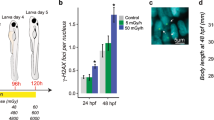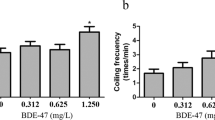Abstract
The negative effects of overexposure to ultraviolet (UV) radiation in humans, including sunburn and light-induced cellular injury, are of increasing public concern. 4-Methylbenzylidene camphor (4-MBC), an organic chemical UV filter, is an active ingredient in sunscreen products. To date, little information is available about its neurotoxicity during early vertebrate development. Zebrafish embryos were exposed to various concentrations of 4-MBC in embryo medium for 3 days. In this study, a high concentration of 4-MBC, which is not being expected at the current environmental concentrations in the environment, was used for the purpose of phenotypic screening. Embryos exposed to 15 μM of 4-MBC displayed abnormal axial curvature and exhibited impaired motility. Exposure effects were found to be greatest during the segmentation period, when somite formation and innervation occur. Immunostaining of the muscle and axon markers F59, znp1, and zn5 revealed that 4-MBC exposure leads to a disorganized pattern of slow muscle fibers and axon pathfinding errors during the innervation of both primary and secondary motor neurons. Our results also showed reduction in AChE activity upon 4-MBC exposure both in vivo in the embryos (15 μM) and in vitro in mammalian Neuro-2A cells (0.1 μM), providing a possible mechanism for 4-MBC-induced muscular and neuronal defects. Taken together, our results have shown that 4-MBC is a teratogen and influences muscular and neuronal development, which may result in developmental defects.







Similar content being viewed by others
References
Altringham JD, Ellerby DJ (1999) Fish swimming: patterns in muscle function. J Exp Biol 202:3397–3403
Anwar K (2004) Toxic effects of cypermethrin on the development of muscle in chick embryo of Gallus domesticus. Int J Agric Biol 6:2
Balmer ME, Buser HR, Müller MD, Poiger T (2005) Occurrence of some organic chemical UV filters in wastewater, in surface waters, and in fish from Swiss lakes. Environ Sci Tech 39:953–962
Behra M, Cousin X, Bertrand C, Vonesch JL, Biellmann D, Chatonnet A, Strahle U (2002) Acetylcholinesterase is required for neuronal and muscular development in the zebrafish embryo. Nat Neurosci 5:111
Brennan C, Mangoli M, Dyer CEF, Ashworth R (2005) Acetylcholine and calcium signaling regulates muscle fibre formation in the zebrafish embryo. J Cell Sci 118:5181–5190
Chen TH, Wang YH, Wu YH (2011) Developmental exposures to ethanol or dimethylsulfoxide at low concentrations alter locomotor activity in larval zebrafish: implications for behavioral toxicity bioassays. Aquat Toxicol 102:162–166
Cheng SH, Wai AWK, So CH, Wu RSS (2000) Cellular and molecular basis of cadmium-induced deformities in zebrafish embryos. Environ Toxicol Chem 19(12):3024–3031
Chow ESL, Cheng SH (2003) Cadmium affects muscle type development and axon growth in zebrafish embryonic somitogenesis. Toxicol Sci 73:149–159
Coleman BA, Taylor P (1996) Regulation of acetylcholinesterase expression during neuronal differentiation. J Biol Chem 271:4410–4416
Crow MT, Stockdale FE (1986) The developmental program of fast myosin heavy chain expression in avian skeletal muscles. Dev Biol 118:333–342
Durrer S, Maerkel K, Schlumpf M, Lichtensteiger W (2005) Estrogen target gene regulation and coactivator expression in rat uterus after developmental exposure to the ultraviolet filter 4-methylbenzylidene camphor. Endocrinology 146:2130–2139
Ellman GL, Courtney KD, Andes V, Featherstone RM (1961) A new and rapid colorimetric determination of acetylcholinesterase activity. Biochem Pharm 7:88–95
Fashena D, Westerfield M (1999) Secondary motoneuron axons localize DM-GRASP on their fasciculated segments. J Comp Neurol 406:415–424
Giokas DL, Salvador A, Chisvert A (2007) UV filters: from sunscreens to human body and the environment. Trends Anal Chem 26:360–374
Gomez TM, Spitzer NC (1999) In vivo regulation of axon extension and pathfinding by growth-cone calcium transients. Nature 6717:350–355
Gruber SJ, Munn MD (1998) Organophosphate and carbonate insecticide in agricultural waters and cholinesterase (ChE) inhibition in Common carp (Cyprinus carpio). Archit Environ Control Toxicol 35:391–396
Hagedorn-Leweke U, Lippold BC (1995) Absorption of sunscreens and other compounds through human skin in vivo: derivation of a method to predict maximum fluxes. Pharm Res 12:1354–1360
Hallare AV, Köhler HR, Triebskorn R (2004) Developmental toxicity and stress protein responses in zebrafish embryos after exposure to diclofenac and its solvent, DMSO. Chemosphere 56(7):659–666
Hanneman E, Trevarrow B, Metcalfe WK, Kimmel CB, Westerfield M (1988a) Segmental pattern of development of the hindbrain and spinal cord of the zebrafish embryo. Development 103(1):49–58
Hanneman E, Trevarrow B, Metcalde WK, Kimmel CB, Westerfield M (1988b) Segmental pattern of development of the hindbrain and spinal cord of the zebrafish. Development 103(1):49–58
Henry TR, Spitsbergen JM, Hornung MW, Abnet CC, Peterson RE (1997) Early life stage toxicity of 2,3,7,8-tetrachlorodibenzo-p-dioxin in zebrafish (Danio rerio). Toxicol Appl Pharmacol 142:56–68
Hofkamp L, Bradley S, Tresguerres J, Lichtensteiger W, Schlumpf M, Timms B (2008) Region-specific growth effects in the developing rat prostate following fetal exposure to estrogenic ultraviolet filters. Environ Health Perspect 116(7):867–872
Howes MR, Perry NSL, Houghton PJ (2003) Plants with traditional uses and activities, relevant to the management of Alzheimer’s disease and other cognitive disorders. Phytother Res 17:1–18
Janjua NR, Mogensen B, Andersson AM, Petersen JH, Henriksen M, Skakkebaek NE, Wulf HC (2004) Systemic absorption of the sunscreens benzophenone-3, octylmethoxycinnamate, and 3-(4-methyl-benzylidene) camphor after whole-body topical application and reproductive hormone levels in humans. J Invest Dermatol 123(1):57–61
Karnovsky MJ, Roots L (1964) A direct colouring thiocholine method for cholinesterase. J Histochem Cytochem 12:219–221
Klann A, Levy G, Lutz I (2005) Estrogen-like effects of ultraviolet screen 3-(4methylbenzylidene)-camphor (Eusolex 6300) on cell proliferation and gene induction in mammalian and amphibian cells. Environ Res 97:274–281
Kunz PY, Galicia HF, Fent K (2006) Comparison of in vitro and in vivo estrogenic activity of UV filters in fish. Toxicol Sci 90:349–361
Langheinrich U (2003) Zebrafish: a new model on the pharmaceutical catwalk. Bioessays 25:904–912
Law RJ, Alaee M, Allchin CR, Boon JP, Lebeuf M, Lepom P, Stern GA (2003) Levels and trends of polybrominated diphenylethers and other brominated flame retardants in wildlife. Environ Int 29:757–770
Layer PG, Weikert T, Alber R (1993) Cholinesterases regulate neurite growth of chick nerve cells in vitro by means of a non-enzymatic mechanism. Cell Tissue Res 273:219–226
Lichtensteiger W, Ceccatelli R, Conscience M, Cotton B, Durrer S, Faass O, Fleischmann I, Ma R, Maerkel K, Schlumpf M (2002) Newly arising endocrine disruptors: UV screens and PBDE. Reprod Toxicol 16:397–398
Metcalfe W, Myers P, Trevarrow B, Bass M, Kimmel C (1990) Primary neurons that express the L2/HNK-1 carbohydrate during early development in the zebrafish. Development 110:491–504
Mirkes P, McClure M, Heindel J, Sander M (2003) Developmental toxicology in the 21st century: multidisciplinary approaches using model organisms and genomics. Birth Defects Res Part Clin Mol Teratol 67:21–34
Miyazawa M, Watanabe H, Kameoka H (1997) Inhibition of acetylcholinesterase activity by monoterpenoids with a p-menthane skeleton. J Agric Food Chem 45:677–679
Nagtegaal M, Ternes TA, Baumann W, Nagel R (1997) UV-Filtersubstanzen in Wasser und Fischen. UWSF-Z Umweltchem Ökotox 9:79–86
Rodil R, Schrader S, Moeder M (2009) Non-porous membrane-assisted liquid–liquid extraction of UV filter compounds from water samples. J Chromatogr A 1216:4887–4894
Ross LS, Parrett T, Easter SS Jr (1992) Axonogenesis and morphogenesis in the embryonic zebrafish brain. J Neurosci 12:467–482
Roy KK, Dixit A, Saxena AK (2008) An investigation of structurally diverse carbamates for acetylcholinesterase (AChE) inhibition using 3D-QSAR analysis. J Mol Graph Model 27(2):197–208
Schlumpf M, Cotton B, Conscience M, Haller V, Steinmann B, Lichtensteiger W (2001) In vitro and in vivo estrogenicity of UV screens. Environ Health Perspect 109:239–244
Schlumpf M, Schmid P, Durrer S, Conscience M, Maerkel K, Henseler M, Gruetter M, Herzog I, Reolon S, Ceccatelli R, Faass O, Stutz E, Jarry H, Wuttke W, Lichtensteiger W (2004) Endocrine activity and developmental toxicity of cosmetic UV filters—an update. Toxicology 205:113–122
Schmitt C, Oetken M, Dittberner O, Wagner M, Oehlmann J (2008) Endocrine modulation and toxic effects of two commonly use UV screens on the aquatic invertebrates Potamopyrgus antipodarum and Lumbriculus variegates. Environ Pollut 152:322–329
Soto AM, Sonnenschein C (2005) Shining a light on sunscreens. Endocrinology 146:2127–2129
Stehr CM, Linbo TL, Incardona JP, Scholz NL (2006) The developmental neurotoxicity of fipronil: notochord degeneration and locomotor defects in zebrafish embryos and larvae. Toxicol Sci 92(1):270–278
Sternfeld M, Ming G, Song H, Sela K, Timberg R, Poo M, Soreq H (1998) Acetylcholinesterase enhances neurite growth and synapse development through alternative contributions of its hydrolytic capacity, core protein, and variable C termini. J Neurosci 18(4):1240–1249
Trevarrow B, Marks DL, Kimmel CB (1990) Organization of hindbrain segments in the zebrafish embryo. Neuron 4:669–679
Westerfield M (1993) A guide for the laboratory use of zebrafish Danio (Brachydanio) rerio. University of Oregon Press, Eugene, OR, USA
Wilson SW, Ross LS, Parrett T, Easter SS Jr (1990) The development of a simple scaffold of axon tracts in the brain of the embryonic zebrafish, Brachydanio rerio. Development 108:121–145
Zhang J, Malayaman S, Davis C, Granato M (2001) A dual role for the zebrafish unplugged gene in motor axon pathfinding and pharyngeal development. Dev Biol 240(2):560–573
Zon LI, Peterson RT (2005) In vivo drug discovery in the zebrafish. Nat Rev Drug Discov 4:35–44
Acknowledgments
The work described in this paper was substantially supported by a grant from the Research Grants Council of the Hong Kong Special Administrative Region, China (Project No. CityU 160110).
Author information
Authors and Affiliations
Corresponding author
Ethics declarations
Conflict of interest
The authors declare that there is no conflict of interest.
Additional information
Responsible editor: Henner Hollert
Rights and permissions
About this article
Cite this article
Li, V.W.T., Tsui, M.P.M., Chen, X. et al. Effects of 4-methylbenzylidene camphor (4-MBC) on neuronal and muscular development in zebrafish (Danio rerio) embryos. Environ Sci Pollut Res 23, 8275–8285 (2016). https://doi.org/10.1007/s11356-016-6180-9
Received:
Accepted:
Published:
Issue Date:
DOI: https://doi.org/10.1007/s11356-016-6180-9




